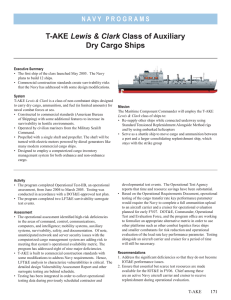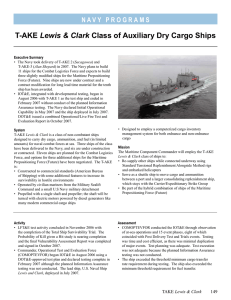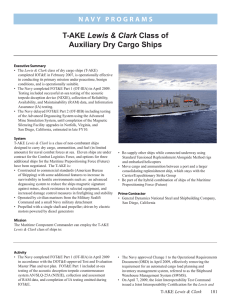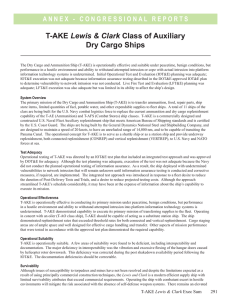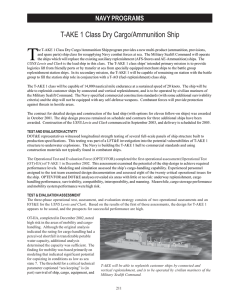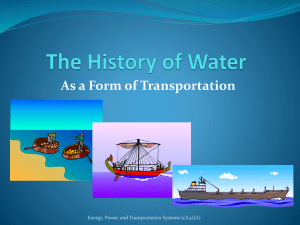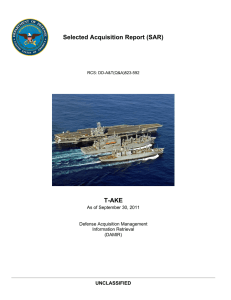Lewis & Clark Auxiliary Dry Cargo Ships
advertisement
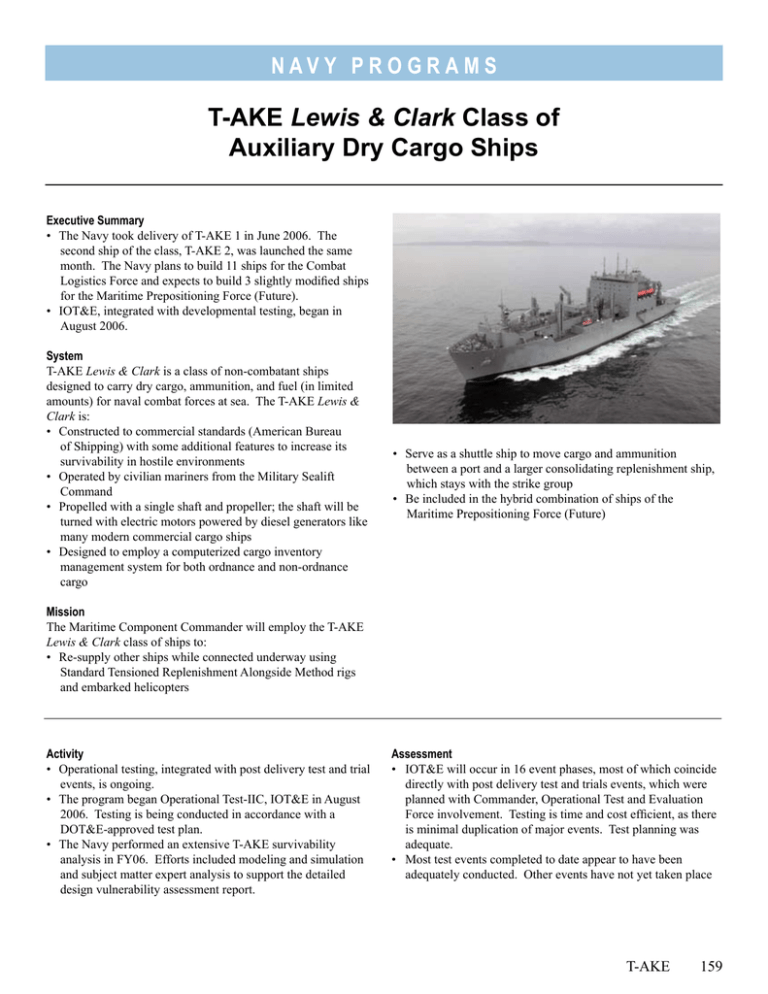
Navy P RO G R A M S T-AKE Lewis & Clark Class of Auxiliary Dry Cargo Ships Executive Summary • The Navy took delivery of T-AKE 1 in June 2006. The second ship of the class, T-AKE 2, was launched the same month. The Navy plans to build 11 ships for the Combat Logistics Force and expects to build 3 slightly modified ships for the Maritime Prepositioning Force (Future). • IOT&E, integrated with developmental testing, began in August 2006. System T-AKE Lewis & Clark is a class of non-combatant ships designed to carry dry cargo, ammunition, and fuel (in limited amounts) for naval combat forces at sea. The T-AKE Lewis & Clark is: • Constructed to commercial standards (American Bureau of Shipping) with some additional features to increase its survivability in hostile environments • Operated by civilian mariners from the Military Sealift Command • Propelled with a single shaft and propeller; the shaft will be turned with electric motors powered by diesel generators like many modern commercial cargo ships • Designed to employ a computerized cargo inventory management system for both ordnance and non-ordnance cargo • Serve as a shuttle ship to move cargo and ammunition between a port and a larger consolidating replenishment ship, which stays with the strike group • Be included in the hybrid combination of ships of the Maritime Prepositioning Force (Future) Mission The Maritime Component Commander will employ the T-AKE Lewis & Clark class of ships to: • Re-supply other ships while connected underway using Standard Tensioned Replenishment Alongside Method rigs and embarked helicopters Activity • Operational testing, integrated with post delivery test and trial events, is ongoing. • The program began Operational Test-IIC, IOT&E in August 2006. Testing is being conducted in accordance with a DOT&E-approved test plan. • The Navy performed an extensive T-AKE survivability analysis in FY06. Efforts included modeling and simulation and subject matter expert analysis to support the detailed design vulnerability assessment report. Assessment • IOT&E will occur in 16 event phases, most of which coincide directly with post delivery test and trials events, which were planned with Commander, Operational Test and Evaluation Force involvement. Testing is time and cost efficient, as there is minimal duplication of major events. Test planning was adequate. • Most test events completed to date appear to have been adequately conducted. Other events have not yet taken place T-AKE 159 Navy P RO G R A M S • • • • or data has not been assessed to fully determine adequacy at the time of this report. Acoustic testing involving the torpedo decoy system could not be conducted due to a system malfunction. The infrastructure is not in place to conduct full testing and calibration of the Advanced Degaussing System, which is intended to reduce the ship’s magnetic signature. Additional facilities will not be completed before FY08. Correction of deficiencies to the computerized cargo management system is proceeding slower than expected due to technical challenges. The Navy’s intent is to defer testing of the computerized cargo management system until T-AKE 2. IOT&E will require that T-AKE 1 demonstrate the ability to conduct cargo management using legacy information and data systems. The T-AKE is being constructed to commercial American Bureau of Shipping standards, using commercial construction materials and processes not as robust as those used in 160 T-AKE constructing combatant ships. The LFT&E program will assess whether these standards are adequate for T-AKE to accomplish its mission The Navy is incorporating some additional survivability features, such as emergency power and communications, which exceed the American Bureau of Shipping standards. Recommendations • Status of Previous Recommendations. The Navy has taken action on one of the two FY05 recommendations and is making progress addressing the second. • FY06 Recommendations. The Navy should: 1. Conduct acoustic testing with the installed acoustic decoy during the scheduled IOT&E period or during follow-on testing and evaluation. 2. Schedule follow-on testing and evaluation to accomplish adequate testing of the cargo management system, as well as the Advanced Degaussing System.
